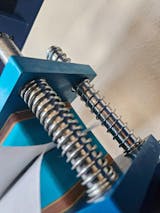Extracting rosin is more art than science.
But there is one hard and fast rule.
Nothing affects the quality of your output more than the quality of your input.
If you use low-quality flowers, you will get low-quality rosin, no matter what temperature, pressure, or pressing time you use.
And if you use high-quality input material, you will get high-quality output.
That said, the temp, pressure, and time settings you use while pressing do play a role.
But humidity plays a bigger role. After the quality of material, the relative humidity is the second most important factor.
Then comes finding the right balance between pressing time, pressure, and temperature.
That balance will be different for every type and strain of input material. You'll have to adjust and fine-tune until you get it just right.
Because of that, I can't give you the exact value for any of those three factors. But I can give you a good starting point.
I'll cover that below and also give you the ideal relative humidity. That factor does not change. You always want to make sure the humidity of your material is in the ideal range.
And what is that range?
Here's a quick summary for those who prefer not to read much more.
Short Answers
Best Humidity
Between 58% and 62%. Read more below.
Best Temperature
The best temperature for kief or hash is between 170° and 190° F. Start with 180° F. The ideal range for the flower is 215° to 230° F. Start with 220° F. Read more below.
Best Pressing Time
Start with a pressing time of around 65 seconds for kief or hash and around 40 seconds for flower. Read more below.
Best Pressure
The ideal pressure is 300 to 700 psi for hash, 400 to 800 psi for kief, and 600 to 1000 psi for flower. Read more below.
Best Humidity For Rosin
The relative humidity of your plant material plays a huge role in the yield. When someone pressing for the first time complains of low yields, it is almost always the result of the flowers being too dry.
Overly dry material wants moisture, so it soaks up a lot of the rosin before it gets out. This results in much smaller yields than you should be getting.
The ideal relative humidity for rosin extraction is 55% to 62%. I would shoot for the higher end of the range, so 58% to 62%.
The easiest way to ensure your material is at the correct humidity is to store it overnight with a humidity pack like this one from Boveda.* It will bring the material up to the right humidity, so that it is ready to be pressed the next day.
What Is The Best Temperature For Rosin?

The most important factor is to keep the temperature below 230° F. Once you get around that temperature, the terpenes simply evaporate. You also get more of a shattery consistency over 220° F.
The ideal range for oil extraction is between 170° and 230° F. When pressing flower, you want to keep the temperatures at the higher end of the range, and when pressing hash or dry sift/kief, you want to keep it at the lower end of the range.
Let’s look at hash or dry sift (kief) first.
Best Temperature To Press Kief (Dry Sift) or Hash
The best temperature for pressing kief or hash is between 170° and 190° F. I recommend starting at 180° F for 65 seconds and adjusting from there.
When pressing kief (or hash) you want to keep the temperature lower, but increase the pressing time. This way, you don’t degrade the terpenes from too high a temperature, but still get good yields due to the longer pressing time.
How Long To Press Kief (Dry Sift) or Hash
Start with a pressing time of 65 seconds at 180° F and adjust from there.
As mentioned, since you are decreasing the temperatures for hash and dry sift, you want to increase the pressing time.
Best Temperature and Time To Press Flower
The ideal range for pressing flower is between 215° and 230° F. I’d start at 220° for about 40 seconds and adjust from there.
If you prefer a rosin with a more batter-like consistency, you’ll want to press much colder and longer. Use a temperature between 160° and 190° F and press for 1 to 5 minutes. This will maximize terpene preservation, but at a sacrifice in yield.
How Much Pressure To Make Rosin

Many people who make their own rosin press get 20-ton jack presses because they think more pressing power is better. That is not quite true.
The important figure is psi (pounds per square inch) in the bag. The overall pressing power of a press is only one factor that affects psi in the bag.
Another factor is the size of the bag (which is obviously also related to the size of the pressing plates). The ideal plates and bags are long and narrow. A rectangular shape gives you more perimeter (where the rosin can escape the bag) and less area in the middle (where the rosin can get stuck).
Rectangular bags thus give better yields from a smaller pressing area, i.e., the total size of the bag in square inches (or square centimeters). Since the bag's surface area of the bag is smaller, you need less overall pressing power to deliver the required psi.
We’ll look at an example below to help make this all clear.
First, let’s see what the required psi actually is.
Best PSI For Rosin
To see the best psi for rosin extraction, let’s take a look at a graph from our friends at PurePressure. It shows the ideal psi ranges for various types of input material.
As you can see, the ideal psi ranges from 300 to 1000, with more pressure required for flower and less for kief or hash.
Specifically, the best range for hash, kief, and flower is:
-
Ideal PSI for Hash: 300 to 700 psi
-
Ideal PSI for Dry Sift/Kief: 400 to 800 psi
-
Ideal PSI for Flower: 600 to 1000 psi
Pressing Power Example
Alright, let’s look at an example to calculate how much pressing power we need to deliver the required psi. For this example, we’ll use 1000 psi as our target, the highest you’ll ever need.
PSI is pounds per square inch, so it is calculated by taking the total pressing power (in pounds) and dividing by the total pressing area (in square inches).
PSI = Pressing Power / Pressing Area
Since we already know the PSI, we have:
1000 psi = Pressing Power / Pressing Area
We can figure out the pressing area, too. Let’s take a 2-by-6-inch bag for our example. The surface area of that bag is 12 square inches. Now we have:
1000 psi = Pressing Power / 12 sq in
To calculate the pressing power required, we multiply both sides of that equation by 12:
12 sq in * 1000 psi = Pressing Power * 12 sq in / 12 sq in
The two "12 sq in" on the right side of the equation cancel each other out, leaving us:
12,000 pounds = Pressing Power
12,000 pounds is 6 tons, so to deliver the pressure we need, we would need a press capable of delivering 6 tons.
And remember that we did this calculation assuming we want the maximum possible required pressure of 1000 psi. We rarely need that much if we press flower and never need that much for hash or kief.
We also did not factor in the bag seam. That generally reduces the size of the bag by half an inch or so. A smaller bag size ends up reducing the pressing power we need even further.
Given all this, do you ever need a 20-ton press? Or is 12 tons generally sufficient?
12 Ton Vs 20 Ton Rosin Press
If you run various bag sizes through the above calculation, you’ll see that you never really need 20 tons of pressing power. Even for the largest bags, 12 tons will be enough. 15 tons max.
For that reason, I’d always recommend saving some money and going with a 12-ton press if you plan on pressing large amounts. The difference in cost between a 12-ton and a 20-ton press is shown in the comparison table in our review of NugSmasher rosin presses.
For smaller amounts, you don’t need more than 5 tons, and 2 tons is usually sufficient for personal use pressing.
I realize there are many sites out there that will tell you to get the most pressing power you possibly can. Rosin extraction is still new, so there isn't much agreement yet on the best way to do it.
It doesn't help that each strain needs to be pressed slightly differently, with a different temperature, at a different pressure, for a different amount of time than the next strain.
All I can tell you is that the more pressure you put on the material, the more plant matter gets pressed out and into your extract. This makes the extract less pure and is often the cause of dark or green rosin. You also increase the risk of a blowout.
Since the increase in yield from higher pressure (as seen in the graph presented above) is minimal, and the risk of blowout and plant matter in your extract is higher, it makes little sense to use pressure above 1000 psi.
Check out our step-by-step guide for the entire process of extracting rosin for more on this subject.












Comments
Leave a comment